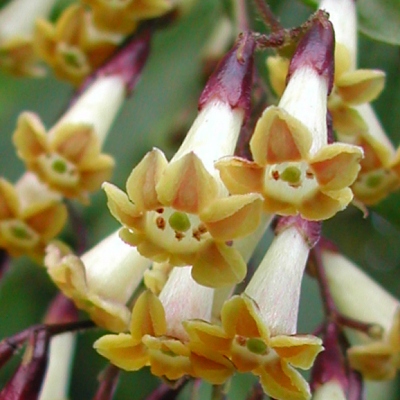| Home |
Strange Wonderful Things Rare and exotic plants |
 |
|---|
Germinating the seeds
When to plant -- Plant your seeds when you receive them for best results.
Getting started -- You may plant each seed in individual, small containers,
such as seedling starter trays. Or you plant them all in a single,
larger
container, but it may be difficult to separate the roots later. Either way, use
containers with drainage holes
For soil, use a well draining
mix. I use a mix of 1 part
coir fiber
to 1 part perlite
(use fine- or medium-grade perlite, not coarse-grade). An alternate mix is 2 parts
quality potting soil
to 1 part perlite.
Fill the pots with the soil mix and water it until it is evenly moist (but not soggy). Place 1 seed on top in each pot, and sprinkle about 1/8 inch (3 mm) of soil over it. Carefully moisten the top soil layer.
Until the seeds sprout, keep the surface soil from drying out. If you place the pots in a plastic container or bag to maintain moisture, leave it open a crack to allow fresh air to enter.
They sprout well between 65 to 77° F (18-25°C). I have no information about how they will germinate outside that temperature
range. I recommend placing a minimum/maximum thermometer near the pots.
Keep them in a bright spot out of direct sun. They should begin sprouting within 4 weeks, but allow up to 12 weeks for any slow ones, especially at cooler temperatures.
Lighting -- Once your seeds sprout, move them to a bright spot, with protection from afternoon sun. You may use a fluorescent or LED light kept a few inches (10 cm) away while your plants are young.
Watering: Once the seedlings are 3 weeks old, you may allow the surface soil to dry out, but aim to keep the rest of the soil evenly moist most of the time. Never let it dry out completely, but also don't keep it perpetually soggy. .
Fertilizing -- The first
6-8 weeks, feed every 7 days with a very dilute (1/8 strength) liquid fertilizer. Hydroponic fertilizer is ideal for this, because it is easily absorbed and contains all essential nutrients. I use General Hydroponics Flora fertilizer, using 1 teaspoon/gallon (5 mL per 4 liters). After 6-8 weeks, you may switch to a granular fertilizer
that contains micronutrients, following the dosage on the package. Or continue feeding weekly with liquid fertilizer at 1/8 strength.
It's normal for a few of the older leaves to
occasionally turn yellow and drop, but if it seems excessive, the soil may be
too dry down in the root zone. If you're unsure if the soil down in the
root zone has the proper moisture, you can use a moisture meter.
If you're certain the roots have been moist enough, the plant may need more
fertilizer.
Climate -- This Cestrum comes mid- to high-elevations, where the climate is mild to cool. I have no information on how much heat it can take, but a related species has been grown successfully in warm places like Florida. Still, consider it experimental in hot climates with warm nights. I don't know its frost tolerance. It grows best above 40 degrees F, although it is probably hardy to 25-30° F (-3°C). Over about 40% humidity is recommended.
Repotting -- Once your seedlings are at least 3 inches tall (7 cm), you may repot them to larger containers about 1 quart (1 liter) in size. Repot gently and avoid letting the soil ball break apart. It's best to water the soil before repotting to keep the soil together. For the first week after repotting, shade from sun and give no fertilizer.
Repot again after 4 to 6 months, or plant in the ground in suitable areas. If you want to keep it in a pot, the final pot size depends on how large you choose to let it grow. You may prune your plant to any size that is convenient. It's best to prune after a flowering flush to avoid removing flower buds.
If you have any questions or problems, please contact me.
Have fun growing them!
- Jeff
Strange Wonderful Things
| Home |
Strange Wonderful Things Rare and exotic plants |
|
|---|---|---|
| Entire site Copyright 2003-2023 by Strange Wonderful Things, except as noted | ||

